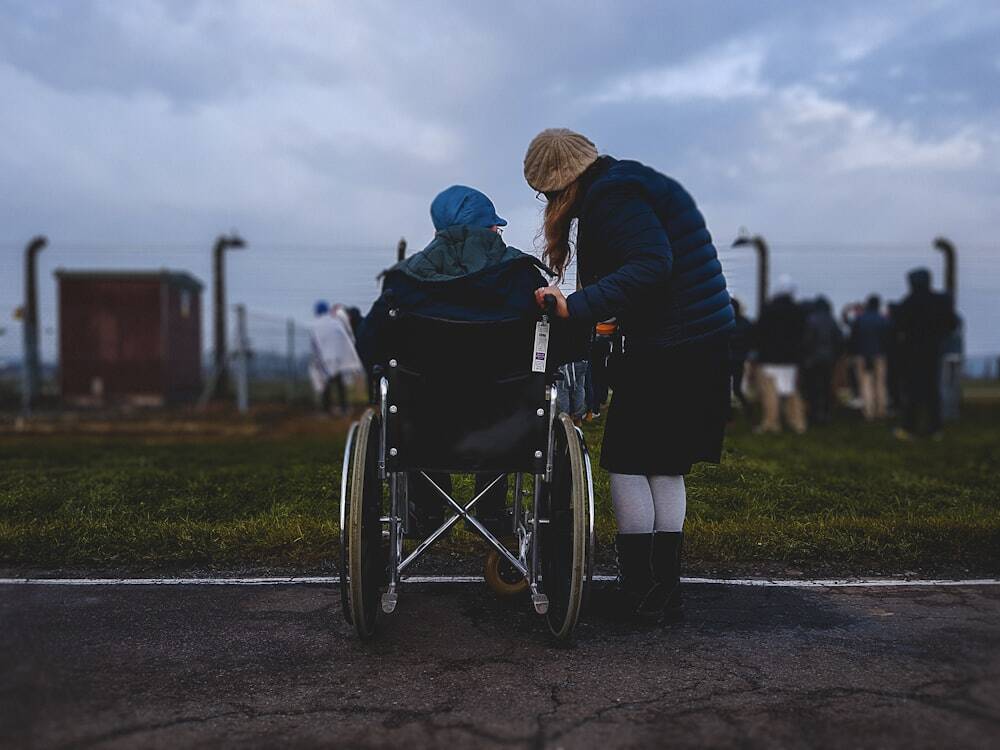Stages Of Alzheimer’s Aggression Alzheimer’s disease is a progressive brain disorder that slowly...
What Is Late Stage Parkinson’s Disease?
What Is Late Stage Parkinson’s Disease?
Late stage Parkinson’s disease is a debilitating and progressive neurological disorder that affects millions of people worldwide. The disease is caused by the degeneration of dopamine-producing neurons in the brain. This can lead to a range of symptoms including tremors, rigidity, bradykinesia (slowness of movement), and postural instability.
As the disease progresses, these symptoms can become more severe and can significantly impact a person’s ability to carry out daily activities.

This disability is often characterized by severe motor impairment, cognitive decline, and other non-motor symptoms. People in this stage of the disease often require significant help with daily activities such as dressing, grooming, and eating.
Symptoms
One of the most prominent symptoms of late stage Parkinson’s disease is the presence of motor fluctuations. Motor fluctuations are characterized by periods of “on” time, where a person experiences a significant improvement in their symptoms. “Off” time, where their symptoms worsen. These fluctuations can be unpredictable and can make it difficult for a person to carry out daily activities.
Another common symptom of late stage Parkinson’s disease is dyskinesia. Dyskinesia is characterized by involuntary movements that can be jerky, twisting, or writhing in nature. These movements can be very distressing for the person experiencing them and can significantly impact their quality of life.
Motor symptoms, people with late stage Parkinson’s disease often experience a range of non-motor symptoms. These can include cognitive impairment, depression, anxiety, sleep disturbances, and autonomic dysfunction (problems with blood pressure, heart rate, and digestion).
Treatment for late stage Parkinson’s disease typically involves a combination of medications, physical therapy, and supportive care. Medications such as levodopa and dopamine agonists can help to manage motor symptoms. While antidepressants and anti-anxiety medications can help to manage non-motor symptoms.
Physical therapy can also be an important part of treatment for late stage Parkinson’s disease. Exercises that focus on improving balance and coordination can help to reduce the risk of falls, while strength training can help to maintain muscle mass and improve overall mobility.
Supportive care is also an important aspect of treatment for late stage Parkinson’s disease. This can include assistance with daily activities such as dressing, grooming, and eating, as well as emotional support for the person and their family.
Importance of Early Detection and Treatment in Managing Symptoms
Early detection and treatment of Parkinson’s disease is critical to managing symptoms and improving the quality of life for people living with the disease. Research has shown that early intervention can significantly reduce the progression of motor symptoms, delay disability, and improve overall outcomes.
One of the key benefits of early detection is that it allows for earlier initiation of medication therapy. Medications such as levodopa have been shown to be highly effective in managing motor symptoms, but they are most effective when started early in the course of the disease.
Delaying treatment can lead to a worsening of symptoms and a reduced response to medication.
In addition to medication therapy, early detection also allows for earlier implementation of non-pharmacological interventions such as physical therapy and occupational therapy.
These therapies can help to improve balance, coordination, and overall mobility, reducing the risk of falls and other complications.
Early detection also allows for earlier management of non-motor symptoms such as depression, anxiety, and sleep disturbances. These symptoms can significantly impact a person’s quality of life and may require specialized care from mental health professionals.
Overall, early detection and treatment are crucial in managing Parkinson’s disease symptoms and improving outcomes for people living with the disease. It is important to seek medical attention as soon as possible to receive an accurate diagnosis and begin appropriate treatment.
Occupational Therapy in Helping People with Late Stage Parkinson’s Disease Maintain Independence
Occupational therapy can be crucial in helping people with late stage Parkinson’s disease maintain their independence and carry out daily activities. Occupational therapists work with individuals to identify areas of difficulty and develop strategies to overcome these challenges.
One of the primary goals of occupational therapy is to help people with Parkinson’s disease maintain their ability to perform daily activities such as dressing, grooming, and eating. This may involve identifying assistive devices or modifications to the home environment that can make these tasks easier.
Occupational therapists also work with individuals to improve their balance, coordination, and overall mobility. This can help to reduce the risk of falls and other complications associated with late stage Parkinson’s disease.
This therapy can also address non-motor symptoms such as cognitive impairment and depression. Therapists can develop strategies to help individuals manage these symptoms and maintain their quality of life.
Strategies for Managing Pain and Discomfort Associated with Parkinson’s Disease
Pain and discomfort are common symptoms of Parkinson’s disease that can significantly impact a person’s quality of life. While there is no cure for Parkinson’s disease, there are strategies that can be used to manage pain and discomfort.
One strategy for managing pain and discomfort is physical therapy. Physical therapists can help individuals with Parkinson’s disease to improve their posture, reduce muscle tension, and increase flexibility. These exercises can also help to reduce pain associated with rigidity and stiffness.
Another strategy for managing pain is through the use of medications such as nonsteroidal anti-inflammatory drugs (NSAIDs) or opioids. These medications can help to reduce pain associated with Parkinson’s disease, but they should be used with caution due to potential side effects.
In addition to physical therapy and medication, complementary therapies such as massage therapy or acupuncture may also be helpful in managing pain and discomfort. These therapies can help to reduce muscle tension and improve overall relaxation.
Strategies for Managing Speech and Swallowing Difficulties
Speech and swallowing difficulties are common in late stage Parkinson’s disease and can significantly impact a person’s quality of life. These symptoms can be caused by the degeneration of muscles in the mouth and throat, as well as by cognitive impairment.
Speech therapists can develop exercises to improve muscle strength and coordination in the mouth and throat, making it easier for individuals with Parkinson’s disease to speak clearly.
They can also teach strategies such as speaking slowly and taking pauses between words to improve overall communication. They may also recommend modifications to the texture or consistency of food and beverages to reduce the risk of choking.
Medications such as levodopa or dopamine agonists may also be used to manage speech and swallowing difficulties. These medications can help to improve muscle control and coordination, reducing symptoms such as slurred speech or difficulty swallowing.
The Importance of Mental Health Support for People with Late Stage Parkinson’s Disease
Late-stage Parkinson’s disease not only affects a person’s physical abilities but can also have a significant impact on their mental health. People with late-stage Parkinson’s disease often experience depression, anxiety, and other mood disorders that can significantly impact their quality of life.
Depression is one of the most common mental health conditions experienced by people with Parkinson’s disease. Symptoms of depression can include feelings of sadness or hopelessness, loss of interest in activities, changes in appetite or sleep patterns, and difficulty concentrating.
Depression can significantly impact a person’s ability to carry out daily activities and may require specialized treatment from mental health professionals.
Anxiety is another common mental health condition experienced by people with Parkinson’s disease. Anxiety can manifest as excessive worry or fear about everyday situations, panic attacks, and physical symptoms such as sweating or palpitations.
Mental health professionals such as psychiatrists, psychologists, or licensed clinical social workers can provide counseling, therapy, and medication management to help individuals manage their symptoms.
Professional support, support from family members and peers can also be helpful in managing mental health conditions associated with late-stage Parkinson’s disease. Support groups or peer networks allow individuals to connect with others who are experiencing similar challenges and provide an opportunity for sharing coping strategies and emotional support.
Overall, appropriate mental health support is crucial in managing the emotional challenges associated with late-stage Parkinson’s disease. By working closely with healthcare providers and loved ones, individuals can develop effective strategies for managing depression and anxiety while maintaining their overall quality of life.
The Potential Benefits of Complementary Therapies in Managing Motor Symptoms and Improving Overall Well-being
Complementary therapies such as acupuncture and massage therapy may offer some benefits in managing motor symptoms and improving overall well-being for people with Parkinson’s disease. While there is limited scientific evidence to support these therapies, many individuals with Parkinson’s disease report positive experiences.
Acupuncture involves the insertion of thin needles into specific points on the body. It is thought to stimulate the body’s natural healing processes and promote overall wellness. Some studies have suggested that acupuncture may help to reduce tremors, rigidity, and other motor symptoms associated with Parkinson’s disease.
Massage therapy involves the manipulation of soft tissues, such as muscles and tendons, using various techniques such as kneading or stroking. Massage therapy can help to reduce muscle tension, improve circulation, and promote relaxation. Some studies have suggested that massage therapy may help to reduce pain and stiffness associated with Parkinson’s disease.
While there is no cure for Parkinson’s disease, complementary therapies such as acupuncture or massage therapy may offer some benefits in managing motor symptoms and improving overall well-being. It is important for individuals with Parkinson’s disease to work closely with their healthcare team to develop a personalized treatment plan that addresses their unique needs and symptoms.
FAQs
How can I help someone with late stage Parkinson’s disease?
Helping someone with late stage Parkinson’s disease can be challenging, but there are several ways you can provide support. Here are a few suggestions:
- Assist with daily tasks: People with late stage Parkinson’s disease may have difficulty performing basic tasks such as getting dressed, bathing, and preparing meals. Offering to help with these activities can make a big difference in their quality of life.
- Provide emotional support: Dealing with a chronic illness can be emotionally taxing. Lend an ear to your loved one and let them vent their frustrations or fears. Just being there to listen and offer comfort can help them feel less alone.
- Encourage exercise: Although it may be difficult, regular exercise can help improve symptoms of Parkinson’s disease. Encourage your loved one to engage in physical therapy or to try gentle exercises such as yoga or tai chi.
- Stay organized: People with Parkinson’s disease may struggle with memory loss and confusion. Help them stay organized by keeping track of appointments, medications, and other important tasks.
- Maintain social connections: Late stage Parkinson’s disease can be isolating, so it’s important to help your loved one stay connected with friends and family. Plan outings or visits that align with their abilities and interests.
Remember, everyone’s experience with Parkinson’s disease is unique, so it’s important to tailor your support to your loved one’s specific needs and abilities.
What are the common symptoms of late stage Parkinson’s disease?
Common symptoms of late stage Parkinson’s disease include motor symptoms such as tremors, rigidity, and bradykinesia (slowness of movement), as well as non-motor symptoms such as depression, anxiety, cognitive impairment, and sleep disturbances.
How is late stage Parkinson’s disease diagnosed?
Late stage Parkinson’s disease is typically diagnosed based on a combination of clinical assessment and medical history. A neurologist may perform a physical exam to assess motor symptoms and may also order imaging tests such as an MRI or CT scan to rule out other conditions.
What treatments are available for late stage Parkinson’s disease?
Treatments for late stage Parkinson’s disease may include medications such as levodopa and dopamine agonists, physical therapy to improve mobility and balance, occupational therapy to help with daily activities, and supportive care to assist with daily tasks and emotional support.
How can family members provide support for someone with late stage Parkinson’s disease?
Family members can provide support by assisting with daily activities such as dressing and grooming, providing emotional support, accompanying the person to medical appointments, and connecting them with community resources such as support groups or home health services.
It is important for family members to communicate openly with the person about their needs and preferences in order to provide effective support.
Summary
In conclusion, late stage Parkinson’s disease is a debilitating and progressive neurological disorder that can significantly impact a person’s quality of life. Although there is no cure for the disease, there are a range of treatments available that can help to manage symptoms and improve a person’s overall functioning.
It is essential for people with late stage Parkinson’s disease to work closely with their healthcare team to develop an individualized treatment plan that addresses their specific needs and concerns.


